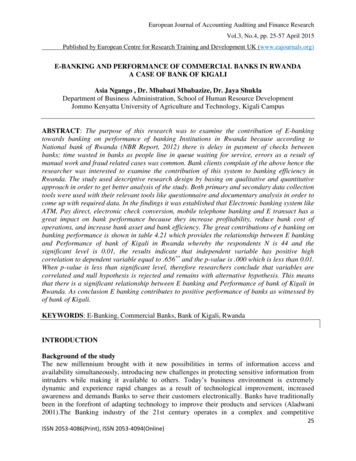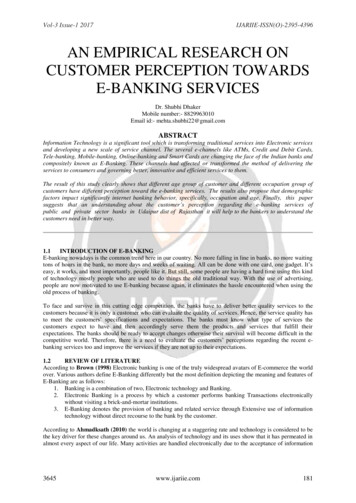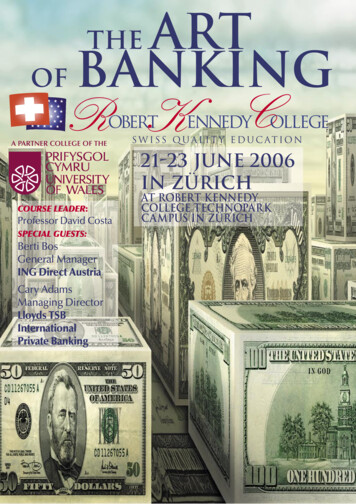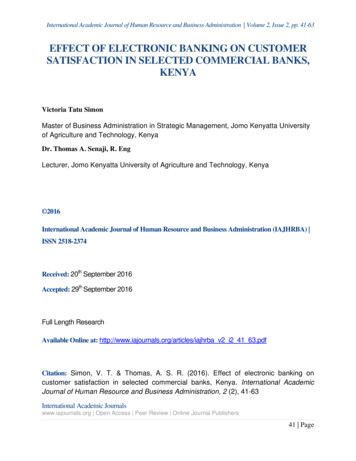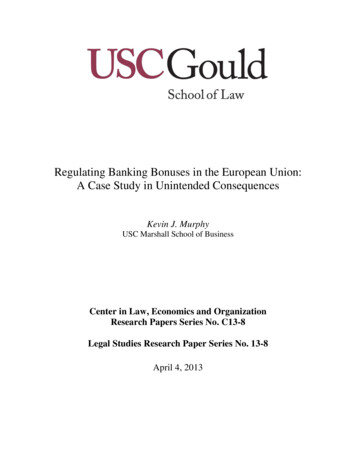
Transcription
Regulating Banking Bonuses in the European Union:A Case Study in Unintended ConsequencesKevin J. MurphyUSC Marshall School of BusinessCenter in Law, Economics and OrganizationResearch Papers Series No. C13-8Legal Studies Research Paper Series No. 13-8April 4, 2013
Regulating Banking Bonuses in the European Union:A Case Study in Unintended ConsequencesKEVIN J. MURPHYKenneth L. Trefftzs Chair in Finance,University of Southern California - Marshall School of Businesskjmurphy@usc.edu18 March 2013AbstractOn 27 February 2013, the European Union (EU) reached a provisional deal to limitthe amount of bankers’ bonuses to the amount of fixed remuneration (i.e., a one-toone ratio); the cap could be increased to 2:1 with the backing of a supermajority ofshareholders. I demonstrate that the pending EU regulations restrictions will: (1)increase rather than decrease incentives for excessive risk taking; (2) result insignificant increase in fixed remuneration; (3) reduce incentives to create value; (4)reduce the competitiveness of the EU banking sector; and (5) result in a generaldegradation in the quality of EU investment bankers, thereby decreasing access tocapital and increasing the cost of capital in the European Union.JEL classification: G32, G34, G38, J33, M12, M52, N20Keywords: Executive compensation, CEO pay, Banking Bonuses, Financial Crisis,Regulation, European UnionAcknowledgementsThis research report has been commissioned by GFMA and its affiliated organizations (AFME,ASIFMA, and SIFMA). However, the views expressed herein are my own, and are based on myextensive published work in the area (see, especially, Murphy (2012b); Conyon, et al. (2013); Murphy(2012a); Murphy (2011); Murphy (2010); Murphy (2009); and Murphy and Jensen (2011)). I gratefulto Devin Dunn for excellent research assistance, and to my co-authors Martin Conyon, NunoFernandes, Miguel Ferreira, Michael C. Jensen, Pedro Matos.Electronic copy available at: http://ssrn.com/abstract 2235395
Regulating Banking Bonuses in the European Union:A Case Study in Unintended ConsequencesKevin J. MurphyUniversity of Southern California1. Introduction and SummaryIn the aftermath of the 2008-2009 financial crisis, regulators on both sides of theAtlantic have considered or implemented rules designed to curb perceived excesses in boththe level of banking bonuses and in the risk-taking incentives provided by those bonuses. Inthe United States, the evolving regulatory proposals have focused on mandated deferrals ofbonuses with explicit clawback provisions; the proposals have stopped short of explicitlylimiting the level of banking bonuses or total remuneration. In Europe, evolving regulatoryproposals have focused on limiting the ratio of variable remuneration to fixed remuneration(e.g., base salaries). In particular, in February 2013, the European Union (EU) reached aprovisional deal to limit the amount of bankers’ bonuses to the amount of fixed remuneration(i.e., a one-to-one ratio); the cap could be increased to 2:1 with the backing of asupermajority of shareholders. The provisional agreement – added as an amendment to thefourth Capital Requirements Directive (CRD-IV) – is expected to be formally approved bythe European Parliament and Council by June 2013 and effective as early as January 2014.The purpose of this report is to provide an economic analysis of the consequences ofthe pending European restrictions on banking bonuses. The articulated objectives of theproposed cap are to reduce excessive risk taking and to reduce perceived excesses in the levelof banking remuneration. I show that the proposed cap is unlikely to achieve either objective.In particular, my primary predictions are briefly summarized as follows: The cap on pay ratios will increase the level of fixed remuneration, making banks muchmore vulnerable to business cycles and downturns and thus significantly increasing therisk of bank failure. The cap on pay ratios will not decrease “excessive” risk taking. In fact, the existing bonussystem – characterized by below-market salaries and high bonus opportunities – provides-1-Electronic copy available at: http://ssrn.com/abstract 2235395
REGULATING EU BANKING BONUSESK. J. MURPHYstrong incentives to avoid “bad” risks and to take “good” risks, while the “capped” bonussystem provides incentives to take bad risks and avoid good risks. The cap on pay ratios will reduce incentives to create value. By focusing only onexcessive risk taking, the regulators ignore the more important purpose of bankingbonuses: to link pay and performance and to provide incentives for employees to takeactions that increase value for shareholders and, ultimately, society. Without question,capping variable remuneration at some multiple of fixed remuneration reduces thesensitivity of pay and performance. Moreover, the “variable” portion of pay willpredictably become less variable, further reducing the sensitivity of pay and performance. While capping the pay ratio will lead to higher levels of fixed remuneration (continuingthe trend evident since the crisis), it will not lead to lower levels of overall remunerationafter adjusting for ability and the risk of the remuneration package. Ultimately, theremuneration for top-performing investment bankers is set in the highly competitiveglobal marketplace, and not by the European Parliament or other regulators. Topperforming investment bankers will predictably have employment opportunities in nonEU banks and other non-bank financial intermediaries not subject to EU restrictions onpay ratios. EU banks will have to offer competitive market remuneration, or they willpredictably lose their most-talented and most-valued employees. Indeed, to the extent thattotal remuneration is reduced by the proposed regulations, it will reflect a less-talentedworkforce as the top producers leave for better-paying opportunities in financial firms notsubject to the pay restrictions. The cap on pay ratios will reduce the competitiveness of the EU banking sector relativeto non-EU banks and other non-bank financial intermediaries and financial-serviceproviders not subject to the EU restrictions. The overall effect of the proposed restrictionswill be to reduce bank flexibility, profitability, and shareholder value, while stiflinginnovation and creativity in EU capital markets. Among the predictable casualties are theEU member states as issuers and guarantors of sovereign debt. The cap on pay ratios will do nothing to cure problems and deficiencies in existing bonusarrangements. In particular, the proposed cap does not address potential problems with-2-
REGULATING EU BANKING BONUSESK. J. MURPHYperformance measurement. These performance measurement problems are inherentlysolvable, but not through one-size-fits all restrictions imposed through regulation.My report proceeds as follows. In Section 2, I provide context for my analysis bydescribing how the structure of banking bonuses has evolved over time and howremuneration has been impacted by the financial crisis due to both economic and politicalpressures. I also describe and contrast the current regulations and proposals affecting bankerremuneration emanating from the United States and the European Union. In Section 3, Ianalyze how capping the ratio of variable-to-fixed pay will impact risk taking, remunerationlevels, and the competitiveness of the EU banking sector. Section 4 provides examples of thecounter-productive and unintended consequences associated with similar attempts to regulateexecutive remuneration, drawing primarily from the long history of pay regulation in theUnited States.2. The Evolution of Banking Bonuses2.1. The Beginning of the Banking Bonus CultureThe heavy reliance on bonuses has been a defining feature of investment-bankingremuneration for decades, dating back to the days when investment banks were privately heldpartnerships. Such firms kept fixed costs under control by keeping base salaries low andpaying most of the remuneration in the form of year-end cash bonuses based on realizedcompany profits. Indeed, the initial purpose for year-end cash bonuses was not the provisionof incentives, per se, but rather a mechanism to ensure that remuneration expense would below in years with low profitability, and high in years with high profitability. Even the socalled “base salary” was often merely a draw on year-end bonuses, and not a truly fixed orguaranteed floor on annual total remuneration. This wage flexibility was especially importantin the highly cyclical financial-services sector.The basic banking-bonus structure remained intact when the investment banks wentpublic, but the cash bonuses were replaced with a combination of cash, restricted shares, andstock options. Base salaries continued to constitute only a small portion of total remuneration-3-
REGULATING EU BANKING BONUSESK. J. MURPHYfor virtually all professional staff, including those in entry-level positions. In addition, yearend bonuses (in cash and equity) were increasingly used explicitly as incentives, to rewardemployees based on individual, group, and firm performance.In the United States, the 1933 Banking Act (often called the “Glass-Steagall Act”)prohibited commercial banks from offering investment-banking services such as issuing,underwriting, selling, or distributing securities. Regulatory changes beginning in the 1960s –and culminating in the 1999 Gramm-Leach-Bliley Act (which effectively repealed largesections of Glass-Steagall) – allowed commercial banks to offer an increasing array ofservices traditionally associated with investment banks. In order to compete with investmentbanks in the marketplace, commercial banks also had to compete in the labor market forinvestment bankers, which meant offering remuneration packages commensurate to those ininvestment banking. Commercial banks offering investment-banking services faced agrowing tension between its traditional commercial bankers – paid high salaries withrelatively little performance-based pay – and the professionals in its on for top performers throughout the organization.The potential rewards and unlimited upside available to top performers allowedfinancial services firms to attract the best and brightest college, MBA, and PhD graduates.The top performers in financial services firms typically have scarce and highly specializedskills that are specific to their industry but not necessarily to their employer. As a result,employees in financial services are remarkably mobile both domestically and internationallywhen compared to employees in virtually any other sector in the economy. This mobility hasincreased overall levels of remuneration, as investment and commercial banks compete witheach other and (increasingly) with private equity and hedge funds on a global basis for scarcetalent.To many outside observers, financial intermediation appears to be a zero-sum game (oreven a negative-sum game) where investment bankers and other financial intermediariesmove euros, dollars, or pound sterling from place to place but do not actually create value.However, concurrent with the expansion in investment bankers and their bonuses was afinancial revolution that created trillions in value (measured in euros, dollars, or pounds). The-4-
REGULATING EU BANKING BONUSESK. J. MURPHYexpansion of original-issue high-yield debt in the 1980s, for example, created a new sourceof capital that rescued hundreds of small and midsize corporations and, by allowingentrepreneurs with little capital to borrow large amounts, fundamentally changed the marketfor corporate control. The expansion of derivative markets in the 1990s allowed corporationsin all sectors to hedge against price and other risks and dramatically reduced their riskexposure. The expansion of securitization in the 1990s and 2000s allowed holders ofresidential and commercial mortgages to pool and share the associated risks with diversifiedinvestors. The expansion of collateralized debt obligations and credit default swaps alsoallowed a more-efficient allocation of risk among diversified and heterogeneous investors.As the demand for these increasingly complex financial instruments increased, so did thedemand for sophisticated finance professionals.1While some might argue that it would be better to have the “best and brightest” college,MBA, and PhD graduates become doctors or public servants and not investment bankers, oneof the great advantages of a capitalist free-market global economy is its propensity to moveresources to higher-valued uses. The best and the brightest were attracted to financialservices firms because of the unlimited upside potential the firms offered for top performers,but this “potential” was available only to the extent that the consumers of financial services(e.g., entrepreneurs, small and large firms, start-ups and mature firms, growing and shrinkingfirms, state and private pension plans, mutual funds, endowments, private-equity firms,venture capitalists, consumers, individual investors, hedge funds, other institutional owners,and issuers and guarantors of sovereign debt) greatly valued those services. Investmentbanking is not a zero-sum game, but in fact creates tremendous value by allowing low-costaccess to existing or new sources of capital, allocating the inherent risk of this capital moreefficiently, and matching buyers and sellers of capital.1Like all innovations, financial innovations can be used unproductively as well as productively. Some banksor investors apparently used these inherently risk-reducing instruments to make un-hedged (and hence highlyrisky) bets, and the failure of these bets likely contributed to the recent financial crisis. However, the limitedmisuse or abuse of these instruments should not diminish their productive role in creating value by creating newsources of capital and by allowing risk to be shared more efficiently.-5-
REGULATING EU BANKING BONUSESK. J. MURPHY2.2. Banking Bonuses and the Financial CrisisThe so-called “Wall Street bonus culture” became highly controversial in the UnitedStates in early 2009 amid revelations that Merrill Lynch paid substantial year-end bonuses toits executives and employees after receiving bailout funds and just prior to completion of itsacquisition by Bank of America. The outrage heightened following the revelation thatinsurance giant American International Group (which had received over 122 billion offederal bailout funds) was in the process of paying 121 million in “retention bonuses” to itsexecutives.2 The public anger over these payments – coupled with beliefs that Wall Streetbonuses were a root cause of excessive risk taking that helped create the ongoing globalfinancial crisis – led to an effective prohibition on cash bonuses for participants in thegovernment’s Troubled Asset Relief Program (TARP) and to more-sweeping regulation ofexecutive remuneration as part of the July 2010 Dodd-Frank Wall Street Reform Act.The anger over bonuses paid by troubled financial institutions was not restricted to theUnited States. In March 2009, pressure mounted on both the French government to limitbanking bonuses after the French bank Natixis SA revealed plans to pay its traders 70million in bonuses for 2008.3 In the same month, Germany’s federal finance minister calledfor a return of Dresdner Bank’s 2008 “obscene” bonuses.4 In August 2009, both Germanyand France announced new rules limiting banking bonuses, and French President NicolasSarkozy and urged leaders of the world’s top 20 developed nations (“G20”) to follow suit.5In early September 2009, the finance ministers of Sweden, the Netherlands, Luxembourg,France, Spain, Germany and Italy jointly demanded that banking bonuses be spread overseveral years, and called for an outright ban on bonus guarantees.6 In addition, PresidentSarkozy was joined by United Kingdom (UK) Prime Minister Gordon Brown and German23US dollar amounts converted to Euros at the 31 Dec 2008 exchange rate of 1:1.3919.Moffett, “France Faces Pressure Over Bonuses As Natixis Sets 94.6 Million Payout,” The Wall StreetJournal (2009).45“Call for Dresdner execs to return bonuses get mixed response,” Banking Newslink (2009).Smith, “Germany’s BaFin Clamps Down On Bank Risk Mgmt, Bonuses,” Dow Jones International News(2009); Davies, “France announces bank bonus crackdown and urges G20 nations to follow suit,” The Guardian(2009); “Germany backs calls to limit banker bonuses,” Agence France Presse (2009); “G-20 Leaders NearBank-Pay Limits Amid Protests,” Associated Press (2009).6“G20 : Buzek Backs Calls to Limit Bankers’ Pay,” Europolitics (2009).-6-
REGULATING EU BANKING BONUSESK. J. MURPHYChancellor Angela Merkel in demanding reforms of “reprehensible practices” within theglobal banking system.7The precise causes of the global financial crisis will be debated for decades (just as theprecise causes of the 1930s depression are still being debated), and it is beyond both thescope of this report and of my ability to provide a detailed account here. However, theevolving consensus suggests that (1) the crisis was related to the collapse in US housingprices (ultimately spreading to a EU sovereign-debt crisis), and (2) the risk-takingcontributing to the crisis reflected a combination of factors (at least in the United States)including social policies on home ownership, loose monetary policies, “Too Big to Fail”guarantees, and poorly implemented financial innovations. These different factors, however,have nothing (or little) to do with the banking bonus culture.Indeed, a reasonable description of the crisis is that it was driven not by excessive risktaking but rather the mistaken assumption that housing prices would continue to appreciate.8Ultimately, home prices that were being artificially bid up by borrowers who could notrealistically qualify for or repay their loans could not continue to increase. When home pricesbegan falling, borrowers who previously would have refinanced or sold their homes at aprofit could do neither, which escalated the pace of foreclosures. Banks who wouldpreviously break even on foreclosed properties now faced huge losses, and the investors ofthe associated mortgaged-back securities or CDOs also suffered. The globalization of worldtrade and long-term capital meant that banks and investors worldwide were affected by theburst in the US housing bubble (Turner (2010)).The maintained assumption of continued appreciation was a mistake of epicproportions, obvious in hindsight but not during the housing boom. But, it was not a mistakedriven by banking bonuses, and most large commercial and investment banks (and theirexecutives) suffered greatly. Indeed, to the extent that compensation systems contributed tothe crisis (such as rewarding loan officers for loans written with little regard to whether the78Monaghan, “Brown sets out plan for bonus clampdown,” The Daily Telegraph (2009).Warren Buffet, for example, called this assumption a “mass delusion” shared by “300 million Americans,”and Citigroup’s CEO called the collapse in housing prices “wholly unanticipated” (Angelides, et al. (2011), p.3).-7-
REGULATING EU BANKING BONUSESK. J. MURPHYloan could be repaid9), it was because the bonuses themselves were designed under theassumption of continued appreciation, and not that the bonuses led to the assumption ofcontinued appreciation.2.3. Banking Bonuses Before and After the CrisisThe 2007-2009 financial crisis had important consequences for the realizedremuneration in large financial services institutions. Table 1 reports the ratio of variable payto fixed pay for EU and US CEOs in banks identified as “Global Systemically ImportantBanks” (G-SIBs) by the Financial Stability Board as of November 2012. Annualremuneration levels and structures for each of the banks in Table 1 are detailed in Figure 1(European Union) and Figure 2 (United States).10As shown in Table 1, the median ratio of variable-to-fixed remuneration for CEOs inEU and US G-SIBs fell significantly during the crisis years from its pre-crisis level, and fullyor partially rebounded in the post-crisis years. For example, the median ratio for CEOs inlarge EU banks fell from 1.8 in 2006-2007 to only 0.2 in 2008, fully rebounding to 1.8 by2010. The median ratio for CEOs in large US banks fell from 24.5 in 2006 to 0 in 2008, andpartially rebounded to 14.0 and 9.3 in 2010 and 2011, respectively. As shown in Figures 1and 2, the level of pay for G-SIB CEOs in the post-crisis period is generally lower than payin the pre-crisis period. Figure 1 shows that only five of the eleven EU CEOs had higher payin 2011 than in 2006.11 Similarly, Figure 2 shows that CEO pay rose for only one of the eightUS CEOs.Ultimately, the most striking difference apparent in Table 1 is the different paypractices in the European Union compared to the United States. In particular, CEOs of US GSIBs receive a significantly higher fraction of their pay in the form of cash bonuses,restricted shares, and stock options in profitable years than do their European counterparts. In9As discussed in detail in Section 3.6 below, paying loan officers on the quantity rather than the quality ofloans is a performance-measurement problem, and not a risk-taking problem.10Because of scant data availability for G-SIBs outside the European Union and United States, myremuneration analysis focuses on EU and US CEOs.11Pre-crisis data are unavailable for UniCredit.-8-
REGULATING EU BANKING BONUSESK. J. MURPHYessence, the pay for US CEOs is consistent with the articulated objective of providing lowpay in years with low profitability, and high pay in years with high profitability.As discussed more fully below, G-SIBs and other large banks faced increased politicalpressure to reduce the variable portion of pay in the aftermath of the financial crisis. Theremuneration trends depicted in Table 1 and Figures 1-2 could therefore reflect both aresponse to these political pressures as well as the normal fluctuation in pay ratios associatedwith fluctuations in performance. Survey evidence reported by Towers Watson (2011)suggests that post-crisis pay decisions in the United Kingdom and Germany were drivenprimarily by business, economic, and competitive factors and not by regulatory and politicalpressures.12Nonetheless, there is some evidence that political pressures are having some effect. Inparticular, while the overall level of pay fell from 2006 to 2011 for 14 of the 21 EU and USG-SIB CEOs in Table 1, the level of fixed remuneration increased. In particular, base salariesincreased for 11 of the 13 EU CEOs and only decreased for two EU CEOs. Similarly, basesalaries increased from 2006 to 2011 for four of the eight US CEOs; salaries fell for twoCEOs and were unchanged for two. In addition, a 2012 survey of 13 EU banks by McLagan(AFME (2012)) finds that fixed remuneration for “banking and capital market professionals”(including equities, fixed income, and investment banking) increased 37% between 2007 and2011.2.4. Recent Regulatory Developments: United StatesIn July 2010, President Obama signed into law the Dodd-Frank Wall Street Reform andConsumer Protection Act or Dodd-Frank Act, which was the culmination of the Presidentand Congress’s controversial and wide-ranging effort to regulate the financial servicesindustry. While the pay restrictions in the TARP legislation applied only to banks receivinggovernment assistance, the Dodd-Frank Act goes much further by regulating pay for allfinancial institutions (TARP recipients and non-recipients, public and private, including12In particular, 84% of the UK Human Resources executive surveyed, and 63% of the German HR executivessurveys, cited business, economic, and competitive factors as the primary driver of remuneration decisions. Incontrast, only 11% and 21% of the UK and German HR executives, respectively, cited regulatory and politicalpressures as the primary driver. See Towers Watson (2011), Table 4.-9-
REGULATING EU BANKING BONUSESK. J. MURPHYFannie Mae and Freddie Mac and US-based operations of foreign banks). Specifically, Part(a) of Section 956 of the Dodd-Frank Act requires all financial institutions to identify anddisclose (to their relevant regulator) any incentive-based remuneration arrangements thatcould lead to material financial loss to the covered financial institution, or that provides anexecutive officer, employee, director, or principal shareholder of the covered financialinstitution with excessive remuneration, fees, or benefits. In addition, Part (b) of Section 956of the Dodd-Frank Act prohibits financial institutions from adopting any incentive plan thatregulators determine encourages inappropriate risks by covered financial institutions, by (1)providing an executive officer, employee, director, or principal shareholder of the coveredfinancial institution with excessive remuneration, fees, or benefits; or (2) that could lead tomaterial financial loss to the covered financial institution.The responsibility for implementing Section 956 of the Dodd-Frank Act fell jointly toseven agencies: the Securities and Exchange Commission, the Federal Reserve System, theOffice of the Comptroller of the Currency, the Office of Thrift Supervision, the FederalDeposit Insurance Corporation, the National Credit Union Administration, and the FederalHousing Finance Agency. In March 2011, the seven agencies issued a joint proposal forpublic comment, modeled in part on Section 39 of the Federal Deposit Insurance Act. Whilethe proposal stops short of explicitly limiting the level of executive remuneration, it prohibitsremuneration that is unreasonable or disproportionate to the amount, nature, quality, andscope of services performed. In addition, the proposal calls for firms to identify individualswho have the ability the expose the firm to substantial risk, and demands that (for the largerinstitutions) such individuals have at least 50% of their bonuses deferred for at least threeyears; deferred amounts would be subject to forfeiture if subsequent performancedeteriorates. The “Comment Period” (i.e., when the various agencies invite comments on theproposed rules) ended in May 2011, but final rules have not yet been announced.2.5. Recent Regulatory Developments: The European UnionIn April 2009, the “Group of 20” (G20) leading economies established the FinancialStability Board (FSB) to flag potential problems in the global financial system. The newlyformed FSB immediately issued guidelines for banking bonuses, recommending that bonuses-10-
REGULATING EU BANKING BONUSESK. J. MURPHYshould be adjusted for the risk the employee takes, should be linked to performance, shouldbe deferred to take account of the duration of the risks being taken, and should be paid in amixture of cash and equity.13 In August 2009, French President Sarkozy indicated that hewould push for limits on banking bonuses at the upcoming G20 summit. Ultimately,President Sarkozy’s hope for the G20 nations to agree to a global cap on banking bonusesfailed after the UK and United States indicated that the proposed cap was too restrictive.14However, at the Pittsburgh G20 summit, the world leaders agreed to pay regulationsproposed by the Financial Stability Board. Under the FSB proposals, which would apply onlyto the finance sector: At least 40% of each executive’s bonus would be deferred over a number of years,rising to 60% for the bonuses of the most senior executives. The deferral period should be at least three years with at least half paid in the form ofrestricted shares rather than cash. Cash payments should be subject to clawback provisions.The FSB’s proposals were designed as an international framework, leaving it to eachcountry to pass country-specific legislation to implement it. Ultimately, in spite of the factthat President Obama had agreed to the FSB framework, the US Federal Reserve (the keybanking regulator in the United States) rejected the FSB recommendations, arguing that asingle formula-based approach could exacerbate excessive risk taking.15 However, most EUcountries embraced the recommendations and committed to have legislation in effect by early2010. By late 2009, German banks agreed to voluntarily adopt the FSB recommendationsahead of formal legislation, and the Italy’s central bank began pressuring its country’s sixlargest banks to comply immediately.16 By March 2010, eight G20 countries – including the1314Larsen, “Rules unlikely to end bonus furore,” Financial Times (2009).Jagger and Frean, “Sarkozy back-pedals over his demands for worldwide cap on banking bonuses,” TheTimes (2009).1516Braithwaite, Guha and Farrell, “Fed rejects global formula for bonuses,” Financial Times (2009).Wilson, “German banks set to speed up pay reform,” Financial Times (2009); “C-bank calls upon Italianbanks to stick to managers’ pay rules,” (2009). Italy’s UniCredit indicated that it was already in full compliance“Unicredit: New Salary Regulations Already Implemented,” ANSA - English Corporate News Service (2009);-11-
REGULATING EU BANKING BONUSESK. J. MURPHYUK, France, and Germany – had adopted new remuneration regulations consistent with theFSB recommendations.In March 2010, a top lawmaker in the European Parliament proposed that there shouldbe “an appropriate balance” between bonuses and salaries, and that bonuses should not makeup more than 50 per cent of total annual remuneration.17 The Parliament’s Committee onEconomic and Monetary Affairs (ECON) formally recommended capping the ratio ofvariable-to-fixed remuneration in June 2010.18 The proposed cap on variable pay wasultimately dropped on June 30 after negotiations with the Council of Ministers and theEuropean Commission.19 Instead, the Parliament approved rules largely in line with theearlier FSB recommendations.In December 2010, the Committee of Europ
University of Southern California - Marshall School of Business kjmurphy@usc.edu 18 March 2013 . capital and increasing the cost of capital in the European Union. JEL classification: G32, G34, G38, J33, M12, M52, N20 Keywords: Executive compensation, CEO pay, Banking BonusesFinancial Crisis, , Regulation, European Union Acknowledgements


